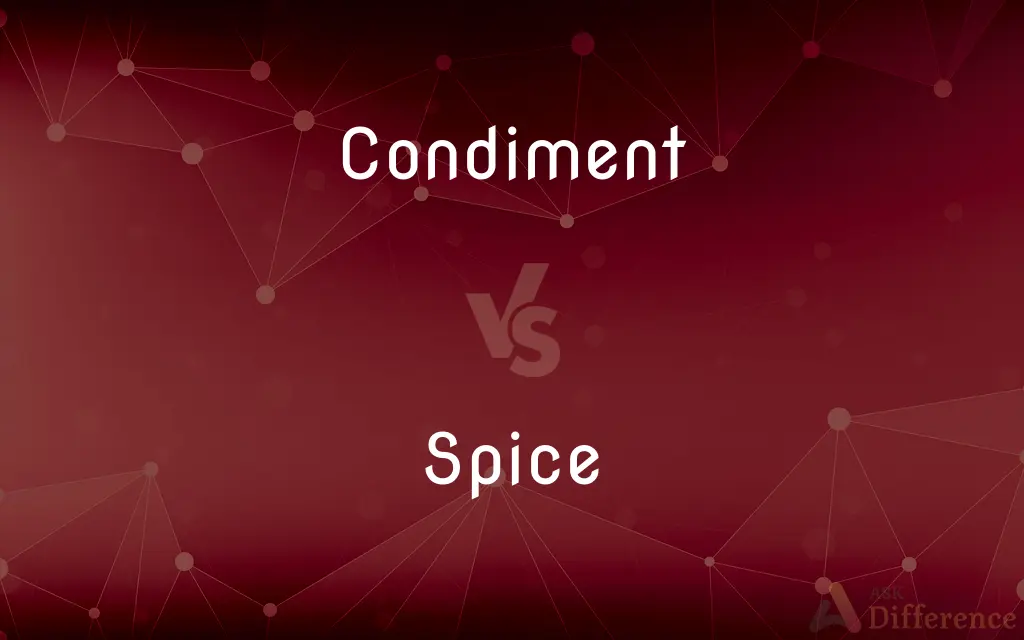Condiment vs. Spice — What's the Difference?
By Tayyaba Rehman & Fiza Rafique — Updated on March 7, 2024
Condiments are versatile flavor enhancers used alongside or added to food, offering a broad range of tastes and textures, while spices are specific types of seasonings derived from plants, used to add flavor, aroma, and sometimes heat to dishes.

Difference Between Condiment and Spice
Table of Contents
ADVERTISEMENT
Key Differences
Condiments encompass a wide variety of sauces, spreads, and pickled foods, used to complement or enhance the flavor of dishes. They can range from ketchup and mustard to mayonnaise and soy sauce, offering a spectrum of tastes from sweet to savory and tangy. On the other hand, spices are typically dried parts of plants, such as seeds, fruits, roots, and bark, ground into powder or used whole to season food. Examples include cinnamon, cumin, and black pepper, each imparting distinct flavors and aromas to culinary creations.
While condiments are often used as final touches, applied at the table or during the last stages of cooking, spices are generally added during the cooking process to infuse dishes with their characteristic flavors and aromas. This distinction highlights the complementary roles condiments and spices play in culinary arts, with condiments serving more as customizable enhancements and spices as integral components of recipes.
The variety within each category reflects cultural and regional culinary practices. For instance, certain condiments like Sriracha sauce are associated with specific cuisines, whereas spices like turmeric have cross-cultural applications, demonstrating the diverse ways these flavorings contribute to global gastronomy.
In terms of health benefits, some spices are known for their medicinal properties, offering antioxidant, anti-inflammatory, and antimicrobial effects, while condiments, depending on their ingredients, can offer nutritional benefits or, conversely, add excess salt, sugar, and fat to diets.
Comparison Chart
Definition
Broad category of flavor enhancers including sauces, spreads, and pickles.
Dried parts of plants used to add flavor, aroma, and sometimes heat.
ADVERTISEMENT
Usage
Applied alongside or on top of dishes, often after cooking.
Added during the cooking process to season food.
Examples
Ketchup, mustard, mayonnaise, soy sauce.
Cinnamon, cumin, black pepper, turmeric.
Origin
Can be made from a variety of ingredients including vegetables, fruits, and dairy.
Derived from seeds, fruits, roots, and bark of plants.
Health Impact
Can add flavor but sometimes contain high levels of salt, sugar, and fat.
Known for medicinal properties such as antioxidant and anti-inflammatory effects.
Compare with Definitions
Condiment
Can include sauces, spreads, and pickles, offering a range of tastes.
For the barbecue, they prepared an assortment of condiments including ketchup and relish.
Spice
A seasoning derived from dried plant parts, used to flavor food.
She seasoned the stew with cumin, a spice known for its warm, earthy flavor.
Condiment
Often used to enhance or complement the main dish.
He drizzled some soy sauce, a savory condiment, over his rice and vegetables.
Spice
Usage varies, but many spices are staples in global cuisines.
Black pepper, one of the most common spices, is used worldwide to enhance flavor.
Condiment
Usage varies across cultures, reflecting regional culinary traditions.
In some Asian cuisines, fish sauce is a crucial condiment, adding umami to dishes.
Spice
Includes seeds, bark, roots, and fruits, ground or whole.
Cinnamon sticks, a spice from tree bark, are used to infuse dishes with a sweet-spicy flavor.
Condiment
A substance used to add flavor to food, often applied after cooking.
She added mustard, a popular condiment, to her sandwich for extra flavor.
Spice
Integral to cooking, often added during meal preparation.
For the curry, he added turmeric, a spice with vibrant color and health benefits.
Condiment
Can be sweet, sour, salty, or spicy, catering to diverse palates.
Honey is sometimes used as a condiment in teas or desserts for its sweetness.
Spice
Can offer medicinal benefits, including antioxidant and anti-inflammatory properties.
Ginger, a widely used spice, is reputed for its digestive and anti-inflammatory effects.
Condiment
A condiment is a spice, sauce, or preparation that is added to food, after cooking, to impart a specific flavor, to enhance the flavor, or to complement the dish. A table condiment or table sauce is more specifically a condiment that is served separately from the food and is added to taste by the diner.
Spice
A spice is a seed, fruit, root, bark, or other plant substance primarily used for flavoring or coloring food. Spices are distinguished from herbs, which are the leaves, flowers, or stems of plants used for flavoring or as a garnish.
Condiment
A substance, such as a relish, vinegar, or spice, used to flavor or complement food.
Spice
An aromatic or pungent vegetable substance used to flavour food, e.g. cloves, pepper, or cumin
The cake is packed with spices
Sift together flour, baking powder, and mixed spice
Condiment
Something used to enhance the flavor of food; for example, salt or pepper.
Spice
A russet or ginger colour.
Condiment
(transitive) To season with condiments.
Spice
Sweets; confectionery.
Condiment
(transitive) To pickle.
Spice
A type of synthetic cannabis
He was smoking spice to cope with his anxiety
Condiment
Something used to give relish to food, and to gratify the taste; a pungment and appetizing substance, as pepper or mustard; seasoning.
As for radish and the like, they are for condiments, and not for nourishment.
Spice
Flavour with spice
Turbot with a spiced sauce
Condiment
A preparation (a sauce or relish or spice) to enhance flavor or enjoyment;
Mustard and ketchup are condiments
Spice
Any of various pungent, aromatic plant substances, such as cinnamon or nutmeg, used to flavor foods or beverages.
Spice
These substances considered as a group.
Spice
Something that adds zest or interest
The controversy added spice to the political campaign.
Spice
A pungent aroma.
Spice
To season with spices.
Spice
To add zest or interest to
Uses witty rhymes to spice up the song.
Spice
Aromatic or pungent plant matter (usually dried) used to season or flavour food.
Spice
(uncountable) The quality of being spicy.
What spice level do you want for your pad thai? I recommend mild.
Spice
Appeal, interest; an attribute that makes something appealing, interesting, or engaging.
Variety is the spice of life
Spice
(uncountable) A synthetic cannabinoid drug.
Spice
Sweets, candy.
Spice
(obsolete) Species; kind.
Spice
A characteristic touch or taste; smack; flavour.
Spice
An aromatic odour.
Spice
(transitive) To add spice or spices to; season.
Spice
(transitive) To spice up.
Spice
Species; kind.
The spices of penance ben three.
Abstain you from all evil spice.
Justice, although it be but one entire virtue, yet is described in two kinds of spices. The one is named justice distributive, the other is called commutative.
Spice
A vegetable production of many kinds, fragrant or aromatic and pungent to the taste, as pepper, cinnamon, nutmeg, mace, allspice, ginger, cloves, etc., which are used in cookery and to flavor sauces, pickles, etc.
Hast thou aught in thy purse [bag] any hot spices?
Spice
Figuratively, that which enriches or alters the quality of a thing in a small degree, as spice alters the taste of food; that which gives zest or pungency; a slight flavoring; a relish; hence, a small quantity or admixture; a sprinkling; as, a spice of mischief.
So much of the will, with a spice of the willful.
Spice
To season with spice, or as with spice; to mix aromatic or pungent substances with; to flavor; to season; as, to spice wine; to spice one's words with wit.
She 'll receive thee, but will spice thy breadWith flowery poisons.
Spice
To fill or impregnate with the odor of spices.
In the spiced Indian air, by night.
Spice
To render nice or dainty; hence, to render scrupulous.
Spice
Aromatic substances of vegetable origin used as a preservative
Spice
Any of a variety of pungent aromatic vegetable substances used for flavoring food
Spice
The property of being seasoned with spice and so highly flavored
Spice
Make more interesting or flavorful;
Spice up the evening by inviting a belly dancer
Spice
Add herbs or spices to
Common Curiosities
What is a condiment?
A condiment is a substance used to enhance the flavor of food, often applied after cooking, and includes sauces, spreads, and pickles.
How are condiments and spices used differently?
Condiments are usually applied to food after cooking or at the table, while spices are added during the cooking process to season dishes.
What are some examples of condiments?
Examples include ketchup, mustard, mayonnaise, and soy sauce.
Are condiments and spices interchangeable?
No, they serve different purposes in cooking and flavoring food, with condiments often applied after cooking and spices used during meal preparation.
What is a spice?
A spice is a seasoning made from dried parts of plants, including seeds, roots, and bark, used to add flavor and aroma to food.
Do condiments have any health benefits?
Some condiments can offer nutritional benefits, depending on their ingredients, but they can also add excess salt, sugar, and fat to diets.
Can spices be used as condiments?
Some spices or spice blends can be used as condiments, especially when mixed into sauces or sprinkled on food at the table.
Can spices be considered condiments?
While spices are primarily used during cooking, some can be part of condiment blends but are generally not considered condiments on their own.
What are some common spices?
Common spices include cinnamon, cumin, black pepper, and turmeric.
Why are spices added during cooking?
Spices are added during cooking to infuse dishes with their flavors and aromas, enhancing the overall taste profile of the food.
What are the health benefits of spices?
Many spices offer medicinal properties, including antioxidant, anti-inflammatory, and antimicrobial effects.
How do cultural differences affect the use of condiments and spices?
Cultural and regional culinary traditions significantly influence the types and usage of condiments and spices, reflecting diverse taste preferences.
Share Your Discovery

Previous Comparison
Exhibition vs. Fair
Next Comparison
Lottery vs. LottoAuthor Spotlight
Written by
Tayyaba RehmanTayyaba Rehman is a distinguished writer, currently serving as a primary contributor to askdifference.com. As a researcher in semantics and etymology, Tayyaba's passion for the complexity of languages and their distinctions has found a perfect home on the platform. Tayyaba delves into the intricacies of language, distinguishing between commonly confused words and phrases, thereby providing clarity for readers worldwide.
Co-written by
Fiza RafiqueFiza Rafique is a skilled content writer at AskDifference.com, where she meticulously refines and enhances written pieces. Drawing from her vast editorial expertise, Fiza ensures clarity, accuracy, and precision in every article. Passionate about language, she continually seeks to elevate the quality of content for readers worldwide.















































